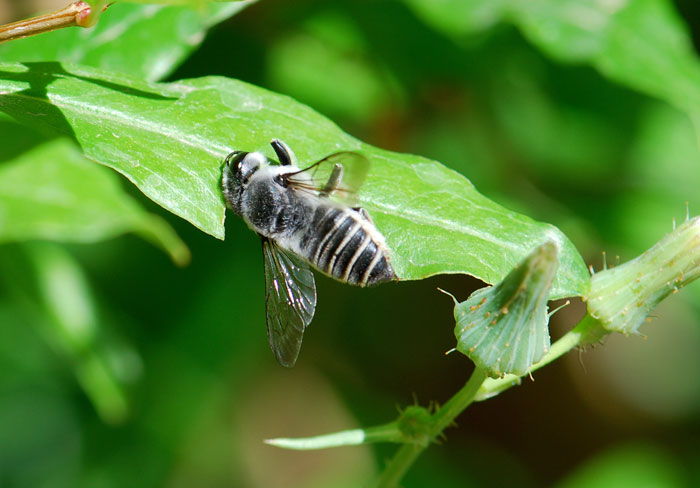You may not know that wild bees pollinate a variety of crops, especially summer vegetable crops like tomatoes, peppers, blueberries, squash, melon and apples. They also supplement the activities of honey bees, which is increasing important when managed honey bee colonies are in a period of decline.
Who are these bees? And what do we need to do to conserve them?
Bumble bees (Bombus spp.) are considered to be the second-most important pollinators after honey bees. They can "buzz-pollinate" (vibrate the pollen off the anthers) - now you know why they're buzzing so loud - and they visit many crops that are not frequented by honey bees. Colonies are established each spring by a single queen.

Sweat bees (Halictus spp.) are small, short-tongued bees with metallic green-blue coloring. They are solitary and visit cane berries and onions.

Leafcutter bees (Megachile spp) are also solitary bees that nest in rotted wood and line their nests with pieces of leaves. The pieces they cut out are smooth circles. They pollinate melons.

Squash bees (Peponapis pruinosa) are solitary ground-nesting bees that are efficient pollinators of cucumbers, melons, pumpkins and squash.
Mason bees (Osmia spp) are prized for their efficient pollination of fruit trees in spring.
You can conserve and attract wild bees to your landscapes by following these guidelines:
- Conserve natural habitats, including both nesting sites and floral resources. "Edge" habitats are especially valuable.
- Plant flowers. Bees need pollen and nectar (together termed "floral resources") to survive. They need food throughout the growing season, so plant a variety of flowering plants with overlapping bloom periods. You can increase access to floral resources by wild bees by planting flowering herbs in your vegetable garden and allowing a portion of your leafy crops to bolt.
- Include native plants in your landscape. Native plants have co-evolved with the insect communities in our region and are best able to provide floral resources to the widest variety of pollinators.
- Provide access to water. Water resources may be scarce during the summer months, so consider maintaining birdbaths, water features or water gardens in your landscape.
- Preserve or build nesting sites. Most wild bees are solitary nesters - the females create individual nests in the ground, in wood or in abandoned nests of other animals. You can conserve nesting sites by leaving some old logs in place and by leaving an undisturbed "edge" area along one or more of the margins of your landscapes. Constructed bee boxes can also be used to encourage wood nesters.
- Reduce wild bee exposure to pesticides. Bees can be poisoned or killed by coming into contact with pesticides found on leaves and flowers on which they forage or the soil when they nest. If chemical controls are necessary in your garden, consider these measures: use a formulation that is least harmful to pollinators; treat the plants when their flowers are not blooming; apply chemicals in the evening when bees are not active; prevent pesticide drift onto naturalized areas of your landscape.
- Plant flowering groundcovers like clover in areas of your garden that you're not cultivating or in parts of your landscape that you're not quite ready to develop. The groundcovers decrease erosion, increase soil fertility and supress weeds in addition to supporting bee populations.


